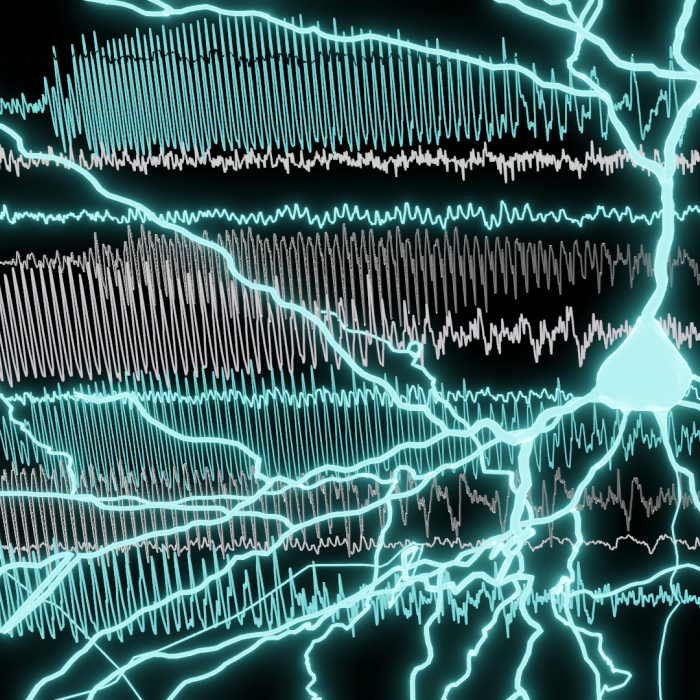
Neurophysiology of Epilepsy
Epilepsy, one of the most pervasive neurological disorders, gives rise to sudden waves of abnormal electrical activity known as seizures. Seizures exhibit great diversity in their region of onset, their electrographic patterns, and their underlying pathology. While recent advances have helped clinicians and researchers to better identify the signs of an oncoming seizure, working out how seizures are triggered in the first place is still a challenge. One major area of interest in the lab is identifying seizure activity and using this to predict seizure onset. We use sophisticated machine learning techniques to build seizure detection and prediction algorithms (e.g., Fumeaux NF. et al., Epilepsia 2020).
Another project in the lab aims to extract the meaningful information encoded within brain signals to understand the mechanisms that underlie spontaneous seizure generation, and how those mechanisms may be disrupted. Efforts in this area have been aimed at determining how various factors play a role in seizure generation, propagation, and termination. Recently we investigated the neurological elements involved in the generation of epileptic seizures by analyzing the occurrence of biomarkers of epilepsy at seizure onset. We have come to realize that there are many different types of neural dynamics that underlie seizures, manifesting over different brain regions and time scales, which we have begun to understand through recent work in our lab (Salami P., et al., Clin Neurophysiol 2020). In the area of seizure termination, we have recently introduced a classification scheme that can be used by future studies to provide useful clues about how seizures may be managed and potentially brought under control through therapeutic intervention (Salami P., et al., Neurobiol Dis 2022).
We also want to understand how seizures start, spread and stop at the level of single neurons and large neuronal populations. By examining the interplay between inhibitory and excitatory neurons, we demonstrated that seizures are not simply manifestations of hyperexcitability and hypersynchrony, as taught in textbooks. Indeed, it is much more likely that seizures originate through a series of complex interactions between different cell populations (Truccolo W., et al., J Neurosci, 2014; Truccolo, W. et al., Nat Neurosci 2011).
There are many lines of inquiry that we are able to pursue in future studies, but in general, our work will continue to focus on revealing the mechanisms underlying seizure generation and propagation, with a view towards developing new modes of seizure diagnosis and therapeutic intervention.
Publications
Fumeaux NF, Ebrahim S, Coughlin BF, Kadambi A, Azmi A, Xu JX, Abou Jaoude M, Nagaraj SB, Thomson KE, Newell TG, Metcalf CS, Wilcox KS, Kimchi EY, Moraes MFD, Cash SS. Accurate detection of spontaneous seizures using a generalized linear model with external validation. Epilepsia. 2020. 61:1906-1918. doi:10.1111/epi.16628.
Salami P, Peled N, Nadalin JK, Martinet LE, Kramer MA, Lee JW, Cash SS. Seizure onset location shapes dynamics of initiation. Clin Neurophysiol. 2020. 131(8):1782-1797. doi: 10.1016/j.clinph.2020.04.168.
Salami P, Borzello M, Kramer MA, Westover MB, Cash SS (2022) Quantifying seizure termination patterns reveals limited pathways to seizure end. Neurobiol Dis. 2022. 165:105645. doi: 10.1016/j.nbd.2022.105645.
Truccolo W, Ahmed OJ, Harrison MT, Eskandar EN, Cosgrove GR, Madsen JR, Blum AS, Potter NS, Hochberg LR, Cash SS. Neuronal ensemble synchrony during human focal seizures. J Neurosci. 2014. 34:9927-9944. PMC4107409
Truccolo W*, Donoghue JA*, Hochberg LR, Eskandar EN, Madsen JR, Anderson WS, Brown EN, Halgren E, and Cash SS. (2011) Single neuron dynamics in human focal epilepsy. Nat Neurosci. 14:635-641. doi:10.1038/nn.2782). Download PDF. View Media
